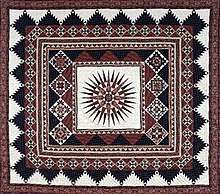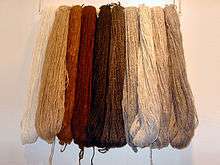Quilting
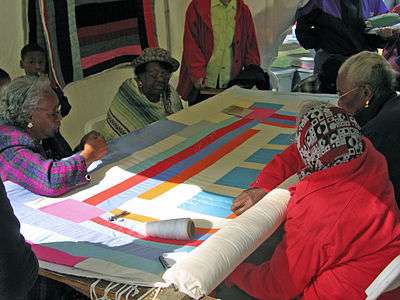
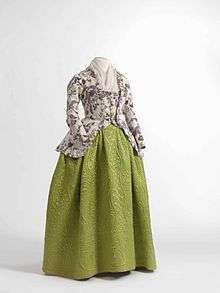
Quilting is the process of sewing two or more layers of fabric together to make a thicker padded material, usually to create a quilt or quilted garment. Typically, quilting is done with three layers: the top fabric or quilt top, batting or insulating material and backing material, but many different styles are adopted.
The process of quilting uses a needle and thread to join two or more layers of material to make a quilt. The quilter's hand or sewing machine passes the needle and thread through all layers and then brings the needle back up. The process is repeated across the entire area where quilting is wanted. Rocking, straight or running stitches are commonly used with these stitches being purely functional or decorative. Quilting is done to create bed spreads, art quilt wall hangings, clothing, and a variety of textile products. Quilting can make a project thick, or with dense quilting, can raise one area so that another stands out.
The whole process of creating a quilt or quilted garment also involves other steps such as designing, piecing, appliqué, and binding. A person who works at quilting is termed a quilter. Quilting can be done by hand, via a sewing machine, or by a specialized longarm quilting system.
Quilt stores often sell fabric, thread, patterns and other goods that are used for quilting. They often have group sewing and quilting classes where one can learn how to sew or quilt.
History
Early quilting
The origins of quilting remain unknown but sewing techniques of piecing, appliqué, and quilting have been used for clothing and furnishings in diverse parts of the world for several millennia.
The earliest known quilted garment is depicted on the carved ivory figure of a Pharaoh dating from the ancient Egyptian First Dynasty (~3400 BC). In 1924 archaeologists discovered a quilted floor covering in Mongolia. They estimated its date as between 100 BC to 200 AD.
In Europe, quilting has been part of the needlework tradition from about the fifth century, with early objects containing Egyptian cotton, which may indicate that Egyptian and Mediterranean trade provided a conduit for the technique. However, quilted objects were relatively rare in Europe until approximately the twelfth century, when quilted bedding and other items appeared after the return of the Crusaders from the Middle East. The medieval quilted gambeson, aketon and arming doublet[1] were garments worn under or instead of armor of maille or plate armor. These developed into the later quilted doublet worn as part of fashionable European male clothing from the fourteenth to seventeenth century. The earliest known surviving European bed quilt is from late-fourteenth-century Sicily: the Tristan quilt made of linen and padded with wool. The blocks across the center are scenes from the legend of Tristan. The quilt is 122" by 106" and is in the Victoria and Albert Museum in London.[2]
The word quilt comes from the Latin culcita meaning a stuffed sack, but it came into the English language from the French word cuilte.[2]
American quilts
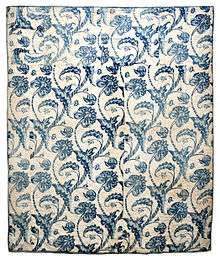
In American Colonial times, quilts were predominantly whole-cloth quilts–a single piece of fabric layered with batting and backing held together with fine needlework quilting. Broderie perse quilts were popular during this time and the majority of pierced or appliqued quilts made during the 1170-1800 period, were medallion-style quilts (quilts with a central ornamental panel and one or more borders.)[3]). Patchwork quilting in America dates to the 1770s, the decade the United States gained its independence from England. These late-eighteenth- and nineteenth-century patchwork quilts often mixed wool, silk, linen, and cotton in the same piece, as well as mixing large-scale (often chintz) and small-scale (often calico) patterns.[4] Some antique quilts made in North America have worn-out blankets or older quilts as the internal batting layer, quilted between new layers of fabric and thereby extending the usefulness of old material.
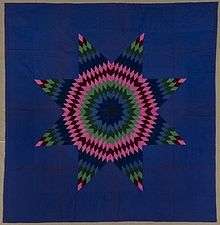
During American pioneer days, paper quilting became popular. Paper was used as a pattern and each individual piece of cut fabric was basted around the paper pattern. Paper was a scarce commodity in the early American west so women would save letters from home, newspaper clippings, and catalogs to use as patterns. The paper not only served as a pattern but as an insulator. The paper found between the old quilts has become a primary source of information about pioneer life.
Quilts made without any insulation or batting were referred to as summer quilts. They were not made for warmth, only to keep the chill off during cooler summer evenings.
African-American quilts
There is a long tradition of African-American quilting beginning with quilts made by slaves, both for themselves and for their owners. The style of these quilts was determined largely by time period and region, rather than race, and the documented slave-made quilts generally resemble those made by white women in their region.[5] After 1865 and the end of slavery in the United States, African-Americans began to develop their own distinctive style of quilting. Harriet Powers, a slave-born African American woman, made two famous story quilts.[6] She was just one of the many African-American quilters who contributed to the evolution of quilting. The first nationwide recognition of African-American quilt-making came when the Gee's Bend quilting community was celebrated in an exhibition that opened in 2002 and traveled to many museums, including the Smithsonian.[7] Gee's Bend is a small, isolated community of African-Americans in southern Alabama with a quilt-making tradition that goes back several generations[8] and is characterized by pattern improvisation, multiple patterning, bright and contrasting colors, visual motion, and a lack of rules.[9] The contributions made by Harriet Powers and others quilters of Gee's Bend, Alabama have been recognized by the US Postal Service with a series of stamps.[10] The communal nature of the quilting process (and how it can bring together women of varied races and backgrounds) was honored in the series of stamps.
Beginning with the children's story Sweet Clara and the Freedom Quilt (1989) a legend has grown that slaves used quilts as a means to share and transmit secret messages to escape slavery and travel the Underground Railroad. Consensus among historians is that there is no sound basis for this belief, and no documented mention among the thousands of slave narratives or other contemporary records.[11][12][13]
Amish quilts
Another American group to develop a distinct style of quilting were the Amish. Typically, these quilts use only solid fabrics, are pieced from geometric shapes, do not contain appliqué, and construction is simple (corners are butted, rather than mitered, for instance) and done entirely by hand. Amish quilters also tend to use simple patterns: Lancaster County Amish are known for their Diamond-in-a-Square and Bars patterns, while other communities use patterns such as Brick, Streak of Lightning, Chinese Coins, and Log Cabins, and midwestern communities are known for their repeating block patterns. Borders and color choice also vary by community. For example, Lancaster quilts feature wide borders with lavish quilting, while Midwestern quilts feature narrower borders to balance the fancier piecing.[14]
Native American quilts
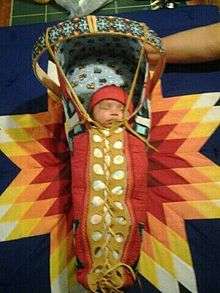
Some Native Americans are thought to have learned quilting through observation of white settlers; others learned it from missionaries who taught quilting to Native American women along with other homemaking skills. Native American women quickly developed their own unique style, the Lone Star design (also called the Star of Bethlehem), a variation on Morning Star designs that had been featured on Native American clothing and other items for centuries. These quilts often featured floral appliqué framing the star design. Pictorial quilts, created with appliqué, were also common.[6]
Another distinctive style of Native American quilting is Seminole piecing, created by Seminoles living in the Florida Everglades. The style evolved out a need for cloth (the closest town was often a week's journey away). Women would make strips of sewing the remnants of fabric rolls together, then sew these into larger pieces to make clothing. Eventually the style began to be used not just for clothing but for quilts as well. In 1900, with the introduction of sewing machines and readily available fabric in Seminole communities, the patterns became much more elaborate and the style continues to be in use today, both by Seminole women and by others who have copied and adapted their designs and techniques.[8]
Hawaiian quilting
"Hawaiian quilting was well established by the beginning of the twentieth century. Hawaiian women learned to quilt from the wives of missionaries from New England in the 1820s. Though they learned both pieced work and applique, by the 1870s they had adapted applique techniques to create a uniquely Hawaiian mode of expression. The classic Hawaiian quilt design is a large, bold, curvilinear appliqué pattern that covers much of the surface of the quilt, with the symmetrical design cut from only one piece of fabric."[15]
South Asian quilting
There are two primary forms of quilting that originate in South Asia: Nakshi Kantha and Ralli. Nakshi Kantha quilts originated in India and are typically made of scraps and worn-out fabric stitched together with old sari threads using kantha embroidery stitches. "The layers of cloth were spread on the ground, held in placed with weights at the edges, and sew together with rows of large basting stitches. The cloth was then folded and worked on whenever there was time."[8] The first recorded kantha are more than 500 years old.
Ralli quilts are traditionally made in Pakistan, western India, and the surrounding area. They are made by every sector of society including Hindu and Muslim women, women of different castes, and women from different towns or villages or tribes with the colors and designs varying among these groups. The name comes from ralanna, a word meaning to mix or connect. Quilts tops were designed and pieced by one woman using scraps of hand-dyed cotton. This cotton often comes from old dresses or shawls. Once pieced, the quilt top is placed on a reed mat with the other layers and sewn together using thick, colored thread in straight parallel lines by members of the designer's family and community.[8]
Swedish quilting
Quilting originated in Sweden in the fifteenth century with heavily stitched and appliquéd quilts made for the very wealthy. These quilts, created from silk, wool, and felt, were intended to be both decorative and functional and were found in churches and in the homes of nobility. Imported cotton first appeared in Sweden in 1870, and began to appear in Swedish quilts soon after along with scraps of wool, silk, and linen. As the availability of cotton increased and its price went down, quilting became widespread among all classes of Swedish society. Wealthier quilters used wool batting while others used linen scraps, rags, or paper mixed with animal hair. In general, these quilts were simple and narrow, made by both men and women. The biggest influence on Swedish quilting in this time period is thought to have come from America as Swedish immigrants to the United States returned to their home country when conditions there improved.[8]
Art quilting
During the late 20th century, art quilts became popular for their aesthetic and artistic qualities rather than for functionality as they are displayed on a wall or table rather than being used on a bed.. "It is believed that decorative quilting came to Europe and Asia during the Crusades (A.D. 1100-1300), a likely idea because textile arts were more developed in China and India than in the West."[16]
Modern quilting
In the early 21st century, modern quilting became a more prominent area of quilting. Modern quilting follows a distinct aesthetic style which draws on inspiration from modern style in architecture, art, and design using traditional quilt making techniques.[17] Modern quilts are different from art quilts in that they are made to be used.[18] Modern quilts are also influenced by the Quilters of Gee's Bend, Amish quilts, Nancy Crow, Denyse Schmidt, Gwen Marston, Yoshiko Jinzenji, Bill Kerr and Weeks Ringle.[19]
Quilting in fashion and design
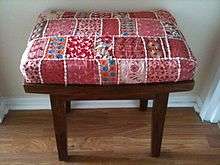
Unusual quilting designs have increasingly become popular as decorative textiles. As industrial sewing technology has become more precise and flexible, quilting using exotic fabrics and embroidery began to appear in home furnishings in the early 21st century.
Quilt blocks
The quilt block is traditionally a sub-unit composed of several pieces of fabric sewn together. The quilt blocks are repeated, or sometimes alternated with plain blocks, to form the overall design of a quilt. Barbara Brackman has documented over 4000 different quilt block patterns from the early 1830s to the 1970s in the Encyclopedia Of Pieced Quilt Patterns.[20] Some of the simpler designs for quilt blocks include the Nine-Patch, Shoo Fly, Churn Dash, and the Prairie Queen.
A Nine Patch is made by sewing five patterned or dark pieces (patches) to four light square pieces in alternating order. These nine sewn squares make one block.[21]
The Shoo Fly varies from the Nine Patch by dividing each of the four corner pieces into a light and dark triangle.[22]
Another variation develops when one square piece is divided into two equal rectangles in the basic Nine Patch design. The Churn Dash block combines the triangles and rectangle to expand the Nine Patch.[23]
The Prairie Queen block combines two large scale triangles in the corner section with the middle section using four squares. The center piece is one full size square. Each of the nine sections does have the same overall measurement and fits together.[2]
Types and equipment
Many types of quilting exist today. The two most widely used are hand-quilting and machine quilting.
Hand quilting is the process of using a needle and thread to sew a running stitch by hand across the entire area to be quilted. This binds the layers together. A quilting frame or hoop is often used to assist in holding the piece being quilted off the quilter's lap. A quilter can make one stitch at a time by first driving the needle through the fabric from the right side, then pushing it back up through the material from the wrong side to complete the stitch; this is called a stab stitch.[24] Another option is called a rocking stitch, where the quilter has one hand, usually with a finger wearing a thimble, on top of the quilt, while the other hand is located beneath the piece to push the needle back up.[25] A third option is called "loading the needle" and involves doing four or more stitches before pulling the needle through the cloth. Hand quilting is still practiced by the Amish and Mennonites within the United States and Canada, and is enjoying a resurgence worldwide.
Machine quilting is the process of using a home sewing machine or a longarm machine to sew the layers together. With the home sewing machine, the layers are tacked together before quilting. This involves laying the top, batting, and backing out on a flat surface and either pinning (using large safety pins) or tacking the layers together.[26] Longarm quilting involves placing the layers to be quilted on a special frame. The frame has bars on which the layers are rolled, keeping these together without the need for tacking or pinning. These frames are used with a professional sewing machine mounted on a platform. The platform rides along tracks so that the machine can be moved across the layers on the frame. A longarm machine is moved across the fabric. In contrast, the fabric is moved through a home sewing machine.
Tying is another technique of fastening the three layers together. This is done primarily on quilts that are made to be used and are needed quickly. The process of tying the quilt is done with yarns or multiple strands of thread. Square knots are used to finish off the ties so that the quilt may be washed and used without fear of the knots coming undone.[27] This technique is commonly called "tacking." In the Midwest, tacked bed covers are referred to as comforters.
Quilting is now taught in some American schools. It is also taught at senior centers around the U.S., but quilters of all ages attend classes. These forms of workshop or classes are also available in other countries in guilds and community colleges.
Contemporary quilters use a wide range of quilting designs and styles, from ancient and ethnic to post-modern futuristic patterns. There is no one single school or style that dominates the quilt-making world. Regardless of skill level, all quilters know the importance of having the right tools when quilting. Having the right tools increases the fluid process of making a quilt and can even be improved over time with practice. Having the right tools will maximize efficiency and make the quilting experience one to remember. Below is a list of the different tools and tips that can be used to make a quilt by hand or machine:[28][29]
A good quality sewing machine is a helpful addition to the process of piecing together a quilt top. Some also use a home sewing machine for quilting together the layers of the quilt, as well as binding the final product. It is important to understand how your particular model functions in order to select the correct settings, thread the needle and bobbin, and operate the machine. Here is a handy guide on using a machine.
- Fabric Markers or Ruler
When making a quilt it is important to mark the fabric that you are cutting in order to have some kind of guidance when cutting the fabric, or you could use a quilting ruler and rotary cutter. When marking the fabric it is advised that you use a fabric marker, which is a marker that washes out when the quilt is washed or will fade away after repeated washes.[28]
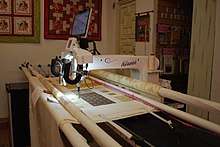
- Longarm quilting Machines
The longarm quilting machine makes it easier to make larger quilts because of the extended arm that is used. Being able to leverage the larger machine and not having to hold the material that is being used while quilting helps the process move along much faster and makes it easier on the quilter.[28] Some quilt shops offer longarm services, where one can pay for their project to be quilted and in some cases, bound as well.
- Machine Quilting Needles
When quilting one of the most important tools that is used is the needle. Whether you are quilting by hand or by machine, the needle that is being used is critical to the final result. Using the wrong needle can lead to puckering, bumps, or even the material being torn. There are many different styles of needles and looking at Sewing Needles will be a good guide.[28]
- Pins and Thimbles
Understanding how pins and thimbles work is also very important in the process of making quilts. Many different combinations of pinning can be used in order get similar results and the exciting part is figuring out existing combinations as well as coming up with new ones. Thimbles are not required but are good for keeping fingers safe.[28]
- Threads
Choosing the right types of threads for a quilt can be difficult and beginners may need some assistance from an expert or more advanced quilter. The color, composition, and type of thread that is used will have a pivotal role in the outcome of the final quilt.[28]
- Rotary Cutters and Boards
What a quilter uses to cut the fabric is a vital step in the quilting process. It is very important each piece is perfectly aligned in order to prevent an uneven or sloppy appearance and to prevent rework. Rotary cutters revolutionized quiltmaking when they appeared in the late 1970s. A rotary cutter offers even the shakiest of hands the ability to produce perfect, even slices and minimizes the chance of error.[30]
- Quilting Templates/Patterns
Quilts can have many different templates or patterns and they can have a large impact on the final result. There are a number of mediums that can be used and depending on the usage, size, and style they will give your quilt a varied look. Templates are generally considered the basis of the structure of the quilt, like a blueprint for a house. If used properly it can help quilters produce a quilt of their liking and give them a sense of satisfaction and vision for future quilts they want to make.[29]
Processes and definitions
Basics of quilt assembly
This section describes basic information about the assembly of quilts using machine quilting techniques. Many cultures and groups in different parts of the world have their own unique approaches, methods and styles of quilting which are not addressed below.
Assembling the quilt top
Selecting fabric
The top-most layer of a quilt is usually made from cotton quilting fabric. Selecting the fabric can be a challenging exercise, and the number of different fabrics required depends on the quilting pattern selected. Many quilters will also make use of fabrics from home, incorporating fabrics with a particular sentimental importance.
Fabric preparation
Newly bought fabric is often washed before being cut or sewn. If not pre-washed, there is a risk of the fabric dyes bleeding during later washing. Many fabric manufacturers take this into account and have taken steps to prevent color-bleeding. Washing, and subsequently drying, the fabric will also shrink some fabrics, so it is best to do this before cutting the fabric into the shapes and sizes needed. The fabric must be ironed flat before cutting to prevent creases or wrinkles from altering measurements.[31]
Cutting fabric
With large-scale projects like quilts, it is often advantageous to have a rotary cutter and mat. A rotary cutter is a cutting tool with a round blade, making it easy to cut a smooth, continuous line. Rotary cutters come with different sized blades: a larger blade is useful for large projects with straight lines, while a smaller blade is helpful for small areas or curved lines. A rotary mat protects tables and surfaces from the blade, while also protecting the cutting edge from damage. A quilting ruler can also be used, to help ensure that all pieces are cut to consistent sizes. Quilting rulers are made of clear plastic and have marked grid-lines across the surface of the ruler. This type of ruler makes it possible to cut a piece of fabric in the correct width or length without having to use a measuring tape and fabric chalk. Measurements have to include a seam allowance.[32]
Sewing the pattern
Once the fabrics have been cut, the pieces are sewn together in the chosen pattern. This can be done by hand or by machine. Accurate seam allowances are especially important when it comes to quilting. With dozens, sometimes hundreds, of different seams, if each seam is off by even 0.5 cm it becomes difficult to make all of the components fit together evenly.[33]
Quilting the sandwich
Layers of quilts
There are generally three layers in a quilt: the quilt top, the middle layer of batting, and the fabric backing. The quilt top is the design layer. The cotton or polyester batting in the middle layer is what determines the warmth of the quilt. Batting comes in different thicknesses depending on the purpose of the final quilt, and multiple layers of batting can be combined to increase the warmth of the final product.[34] The bottom layer is often a simple layer of solid fabric, in a neutral or complimentary color and design scheme, though some quilters use the extra or spare fabric from the quilt top to make a secondary design for the backing.
Basting the layers
Before actually quilting fabrics, some quilters baste the quilt. Basting is the practice of making long, loose stitches in a grid format across the surface of the quilt to hold the layers of the quilt together and to prevent them from shifting during the quilting process. Basting can also be done using large curved safety pins rather than machine or hand basting.[35] Many quilters now use a "spray basting" technique that applies a washable adhesive between the layers.
Quilting
The layers of the quilt are then stitched together, either by hand or through the use of a sewing machine or longarm. One method of quilting involves the use of an outline or stencil applied to the surface of the quilt using fabric chalk, washable marker or iron-on pattern. The quilter will then sew along the applied pattern, washing or wiping the stencil off after the quilt is complete. Some quilters choose not to make use of a pattern. Free-motion quilting is the process of quilting without the use of a stencil or other guide, requiring a steady hand and a great deal of practice. Quilting is usually completed by starting from the middle, and moving outward toward the edges of the quilt. Quilting can be elaborately decorative, comprising stitching fashioned into complex designs and patterns, simple or complex geometric grids, "motifs" traced from published quilting patterns or traced pictures, freehand, or complex repeated designs called tessellations. The quilter may choose to emphasize these designs by using threads that are multicolored or metallic, or that contrast highly to the fabric. Conversely, the quilter may choose to make the quilting disappear, using "invisible" nylon or polyester thread, thread that matches the quilt top, or stitching within the patchwork seams themselves (commonly known as "stitch in the ditch").
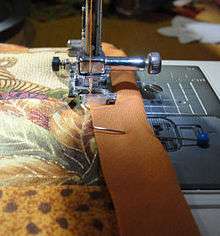
Binding
Once the layers have been quilted, the edges must be finished and bound. There are many different ways to bind a quilt. One of the simplest involves sewing one side of a strip of fabric to the front side of the quilt, through all of the layers of fabric, then folding the strip over to the back side of the fabric and hand stitching the binding closed.[36] If the quilt will be hung on the wall, there is an additional step: making and attaching the hanging sleeve.
In China
Throughout China, a simple method of producing quilts is employed. It involves setting up a temporary roadside site. A frame is assembled within which a lattice work of cotton thread is made. Cotton batting, either new or retrieved from discarded quilts, is prepared in a mobile carding machine. The mechanism of the carding machine is powered by a small, petrol motor. The batting is then added, layer by layer, to the area within the frame. Between each layer, a new lattice of thread is created with a wooden disk used to tamp down the layer.
Definitions
- Piecing: Sewing small pieces of cloth into patterns, called blocks, that are then sewn together to make a finished quilt top. These blocks may be sewn together, edge to edge, or separated by strips of cloth called sashing. Note: Whole cloth quilts typically are not pieced, but are made using a single piece of cloth for the quilt top.
- Pieced quilt: Pieced quilts are also known as patchworks. They consist of geometric shapes taken from different fabrics and are sewn together. After that process, it is referred to as a quilt top. The quilting patterns generally follow the design of the geometric patterns. The quilt ends up being a mixture of different fabrics and geometric designs and shapes that are organized in some fashion.[37]
- Borders: Typically strips of fabric of various widths added to the perimeter of the pieced blocks to complete the quilt top. Note: borders may also be made up of simple or patterned blocks that are stitched together into a row, before being added to the quilt top.
- Layering: Placing the quilt top over the batting and the backing.
- Quilting: Stitching through all three layers of the quilt (the quilt top, the batting, and the quilt back), typically in decorative patterns, which serves three purposes:
- To secure the layers to each other,
- To add to the beauty and design of the finished quilt, and
- To trap air within the quilted sections, making the quilt as a whole, much warmer than its parts.
- Binding: Long fabric strips cut on the bias that are attached to the borders of the quilt. Binding is typically machine sewn to the front side of the edge of the quilt, folded over twice, and hand sewn to the back side of the quilt.
Quilting is often combined with embroidery, patchwork, applique, and other forms of needlework.
Specialty styles
- Foundation piecing – also known as paper-piecing – sewing pieces of fabric onto a temporary or permanent foundation
- Shadow or echo quilting – Hawaiian quilting, where quilting is done around an appliquéd piece on the quilt top, then the quilting is echoed again and again around the previous quilting line.
- Ralli quilting – Pakistani and Indian quilting, often associated with the Sindh (Pakistan) and Gujarat (India) regions.
- Sashiko stitching – Basic running stitch worked in heavy, white cotton thread usually on dark indigo colored fabric. It was originally used by the working classes to stitch layers together for warmth.[38]
- Trapunto quilting – stuffed quilting, often associated with Italy.
- Machine trapunto quilting – a process of using water-soluble thread and an extra layer of batting to achieve trapunto design and then sandwiching the quilt and re-sewing the design with regular cotton thread.
- Shadow trapunto – This involves quilting a design in fine lawn and filling some of the spaces in the pattern with small lengths of colored wool.
- Tivaevae or tifaifai – A distinct art from the Cook Islands.
- Watercolor quilting – A sophisticated form of scrap quilting whereby uniform sizes of various prints are arranged and sewn to create a picture or design. See also Colorwash.
- Thread art – A custom style of sewing where thread is layered to create the picture on the quilt.
Non Quilting, Quilters
There are some artists that are not using quilting techniques of hand sewing, machine sewing or long arm for example, but who the quilting 'world' have taken an interest. Artists like Fraser Smith,[39][40][41] who carves 'quilts' out of wood that look like actual quilts and Ian Berry who uses only denim to create his works, but uses glue, not quilting.[42][43][44][45]
See also
| Wikimedia Commons has media related to Quilting. |
References
- ↑ Archived December 28, 2011, at the Wayback Machine.
- 1 2 3 Johnson, Julie. "History of Quilting". Center for Great Plain Studies. Emporia State University. Retrieved 31 January 2014.
- ↑ Hargrave, Harriet and Carrie (2015). Quilter's Academy Vol. 5–Masters Year. Concord: C&T Publishing. p. 6. ISBN 978-1-57120-792-0.
- ↑ Brackman, Barbara (2004). America's Printed Fabrics: 1770-1890. Concord: C&T Publishing. pp. 6–7. ISBN 1-57120-255-2.
- ↑ Brackman, Barbara (2006). Facts & Fabrications: Unraveling the History of Quilts & Slavery. Concord: C&T Publishing. p. 15. ISBN 978-1-57120-364-9.
- 1 2 Eisenmann, Deanne (2014). Blooming Patchwork. Kansas City, MO: Kansas City Star Books. p. 12. ISBN 978-1-61169-144-3.
- ↑ "History, Travel, Arts, Science, People, Places - Smithsonian". smithsonianmag.com.
- 1 2 3 4 5 Ellis, Cassandra (2014). World of Quilts. Concord, CA: C&T Publishing. pp. 10–150. ISBN 978-1-60705-953-0.
- ↑ Heffley, Scott (2007). Bold Improvisation. Kansas City, Missouri: Kansas City Star Books. pp. 4–10. ISBN 978-1-933466-25-5.
- ↑ Quilts of Gee's Bend commemorative postage stamps Archived June 6, 2011, at the Wayback Machine.
- ↑ "Underground Railroad Quilts: Documentary Evidence is Missing". www.historyofquilts.com.
- ↑ "Archived copy". Archived from the original on February 4, 2013. Retrieved January 23, 2013.
- ↑ "The Jacob's Ladder Pattern Became the Underground Railroad Quilt". www.womenfolk.com.
- ↑ Koolish, Lynn (2013). Amish Quilts–The Adventure Continues. Concord: C&T Publishing. pp. 9–10. ISBN 978-1-60705-791-8.
- ↑ QUILTS. (2003). In The Encyclopedia of American Folk Art. Retrieved from http://www.credoreference.com/entry/routfolkart/quilts
- ↑ Bial, Raymond (1996). With Needle and Thread. Boston, New York: Houghton Mifflin Company. p. 18.
- ↑ Grant, Heather (September–October 2012). "The Birth of Modern Quilting". McCall's Quilting Magazine: 56–58.
- ↑ "What is Modern Quilting?". The Modern Quilt Guild. Retrieved 2017-11-29.
- ↑ May, Rachel (2014). Quilting with a Modern Slant. North Adams, MA: Storey Publishing. pp. 7, 14, 18, 27, 51, 59, 66. ISBN 978-1-61212-063-8.
- ↑ Brackman, Barbara (1993). Encyclopedia of Pieced Quilt Patterns. Paducah, Kentucky: American Quilter's Society. p. 552. ISBN 978-0891458159.
- ↑ The New Quick & Easy Block Tool!. Concord, CA: C&T Publishing. 2016. p. 83. ISBN 978-1-61745-231-4.
- ↑ The New Quick & Easy Block Tool!. Concord, CA: C&T Publishing. 2016. p. 95. ISBN 978-1-61745-231-4.
- ↑ The New Quick & Easy Block Tool!. Concord, CA: C&T Publishing. 2016. p. 34. ISBN 978-1-61745-231-4.
- ↑ "Stab Stitch Quilting". Barbara Robson.
- ↑ Anderson, Alex (2015). All Things Quilting with Alex Anderson. Concord, CA: C&T Publishing. p. 132. ISBN 978-1-60705-856-4.
- ↑ Anderson, Alex (2015). All Things Quilting with Alex Anderson. Concord, CA: C&T Publishing. pp. 129–130. ISBN 978-1-60705-856-4.
- ↑ Anderson, Alex (2015). All Things Quilting with Alex Anderson. Concord, CA: C&T Publishing. p. 154. ISBN 978-1-60705-856-4.
- 1 2 3 4 5 6 "Quilting 101 – Quilt making tips and resources". Quilting. Retrieved 28 January 2014.
- 1 2 Cox, Meg (May 9, 2013). "'Modern Quilters' Stress Simplicity, Edgy Subjects". The Wall Street Journal. Retrieved 28 January 2014.
- ↑ Anderson, Alex (2015). All Things Quilting with Alex Anderson. Concord, CA: C&T Publishing. p. 36. ISBN 978-1-60705-856-4.
- ↑ Beth. "Quilting Basics - Preparing and Cutting". Sew Mama Sew. Retrieved 3 June 2014.
- ↑ Liz, Johnson. "Quilt Basics - Rotary Cutting and Trimming". Sew4Home. Retrieved 3 June 2014.
- ↑ Deborah, Norwood. "How to Sew an Accurate Quarter Inch Seam Allowance". Connecting Threads. Retrieved 3 June 2014.
- ↑ Amy, Smart. "Batting and Backing 101". Diary of a Quilter. Retrieved 3 June 2014.
- ↑ "Quilting Techniques: Basting Quilts". QuiltingAssistant.com. Retrieved 3 June 2014.
- ↑ "Completing Quilt: Finishing Quilt Guide". SewingSpot. Retrieved 18 January 2016.
- ↑ "Quilting 101 – Quilt making tips and resources". Retrieved 28 January 2014.
- ↑ Sharon Pederson,(2005). Sensational Sashiko, Japanese Applique and Quilting by Machine. p.5, Martingale & Co., Woodinville, WA
- ↑ Davis, Mary Kay. "Fraser Smith - Carved Wood Quilts - TheQuiltShow.com". thequiltshow.com. Retrieved 2018-07-09.
- ↑ "Fraser Smith: Carved Quilts Houston Center for Contemporary Craft". Houston Center for Contemporary Craft. Retrieved 2018-07-09.
- ↑ "Can you believe all these beautiful quilts are made out of wood?". Lost At E Minor: For creative people. 2015-10-30. Retrieved 2018-07-09.
- ↑ admin (2016-11-16). "Ian Berry: Behind Closed Doors - TextileArtist.org". TextileArtist.org. Retrieved 2018-07-09.
- ↑ Anderson, John. "Ian Berry: Denim Art - Let's Get Closer - TheQuiltShow.com". thequiltshow.com. Retrieved 2018-07-09.
- ↑ "Artist's work with denim stands out in quilting crowd". WPSD Local 6 - Your News, Weather, & Sports Authority. 2018-04-18. Retrieved 2018-07-09.
- ↑ "spah18-ian-berry". AQS QuiltWeek. Retrieved 2018-07-09.
External links
- Colby, Averil. Quilting. New York: Charles Scribner's Sons, 1971.
- Pennsylvania Folklore: Woven Together TV Program on textile arts
- National Gallery of Australia - Rajah Quilt 1841
- Australian War Memorial - Changi Quilts WW2
- Directory of quilts in Australian Museums and Galleries
- The American Museum in Britain - American Decorative and Folk Art Collection
